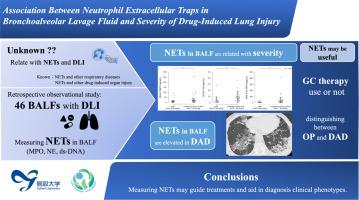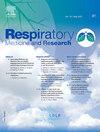支气管肺泡灌洗液中性粒细胞胞外陷阱与药物性肺损伤严重程度的关系
IF 1.8
4区 医学
Q3 RESPIRATORY SYSTEM
引用次数: 0
摘要
中性粒细胞胞外陷阱(NETs)在早期免疫反应中起关键作用,并与多种呼吸系统疾病有关,如急性呼吸窘迫综合征(ARDS)。支气管肺泡灌洗液(BALF)中的NETs与ARDS严重程度之间存在相关性。NETs还与药物引起的器官疾病有关。然而,药物性肺损伤(DLI)与NETs之间的关系尚不清楚。本研究旨在建立和证实这种关系。方法采用回顾性观察性研究。我们提取了在鸟取大学医院行BAL的DLI病例。根据患者是否需要糖皮质激素治疗,将患者分为“中度及以上”组(PaO2≧80 mmHg)和“轻度”组(PaO2≧80 mmHg)。我们检测了balf中的髓过氧化物酶、中性粒细胞弹性酶和双链dna水平,并通过非参数Mann-Whitney U检验检验了它们与临床表现和严重程度的关系。结果对46例DLI患者进行了研究。“中度及以上”组32例,“轻度”组14例,前者BALF NETs明显高于后者。3例高分辨率计算机断层扫描(HRCT)显示弥漫性肺泡损伤(DAD)模式,其NET水平明显高于非DAD模式。结论在DLI中,发现BALF的NETs与疾病严重程度和HRCT图像中DAD模式的存在有关。测量BALF中的NETs在指导未来的治疗选择和帮助临床表型的鉴别诊断方面具有潜在的效用。本文章由计算机程序翻译,如有差异,请以英文原文为准。

Association between neutrophil extracellular traps in bronchoalveolar lavage fluid and severity of drug-induced lung injury
Background
Neutrophil extracellular traps (NETs) play a pivotal role in early immune responses and are implicated in various respiratory diseases, such as acute respiratory distress syndrome (ARDS). A correlation between NETs in bronchoalveolar lavage fluid (BALF) and the severity of ARDS has been reported. NETs are also associated with drug-induced organ disorders. However, the relationship between drug-induced lung injury (DLI) and NETs remains unclear. This study aimed to establish and substantiate this relationship.
Methods
We conducted a retrospective observational study. We extracted DLI cases in which BAL was performed at Tottori university hospital. Based on the need for glucocorticoid treatment, patients were classified into the “moderate severity or above” group (PaO2 < 80 mmHg) and “mild” group (PaO2 ≧ 80 mmHg). We examined myeloperoxidase, neutrophil elastase, and double-strand-DNA levels in BALFs, and examined their association with clinical findings and severity, with non-parametric Mann-Whitney U test.
Results
We studied 46 patients with DLI. The “moderate severity or above” group had 32 patients, while the “mild” group had 14 patients, and NETs in BALF were significantly higher in the former group. Three cases showed a diffuse alveolar damage (DAD) pattern on high-resolution computed tomography (HRCT), with significantly higher NET levels that those with non-DAD patterns.
Conclusion
In DLI, NETs in BALF were found to be related with disease severity and the presence of DAD patterns in HRCT images. Measuring NETs in BALF offer potential utility in guiding future treatment selection and aiding the differential diagnosis of clinical phenotypes.
求助全文
通过发布文献求助,成功后即可免费获取论文全文。
去求助
来源期刊

Respiratory Medicine and Research
RESPIRATORY SYSTEM-
CiteScore
2.70
自引率
0.00%
发文量
82
审稿时长
50 days
 求助内容:
求助内容: 应助结果提醒方式:
应助结果提醒方式:


